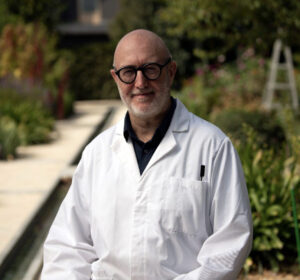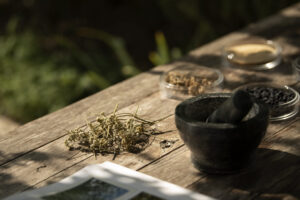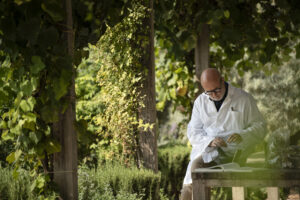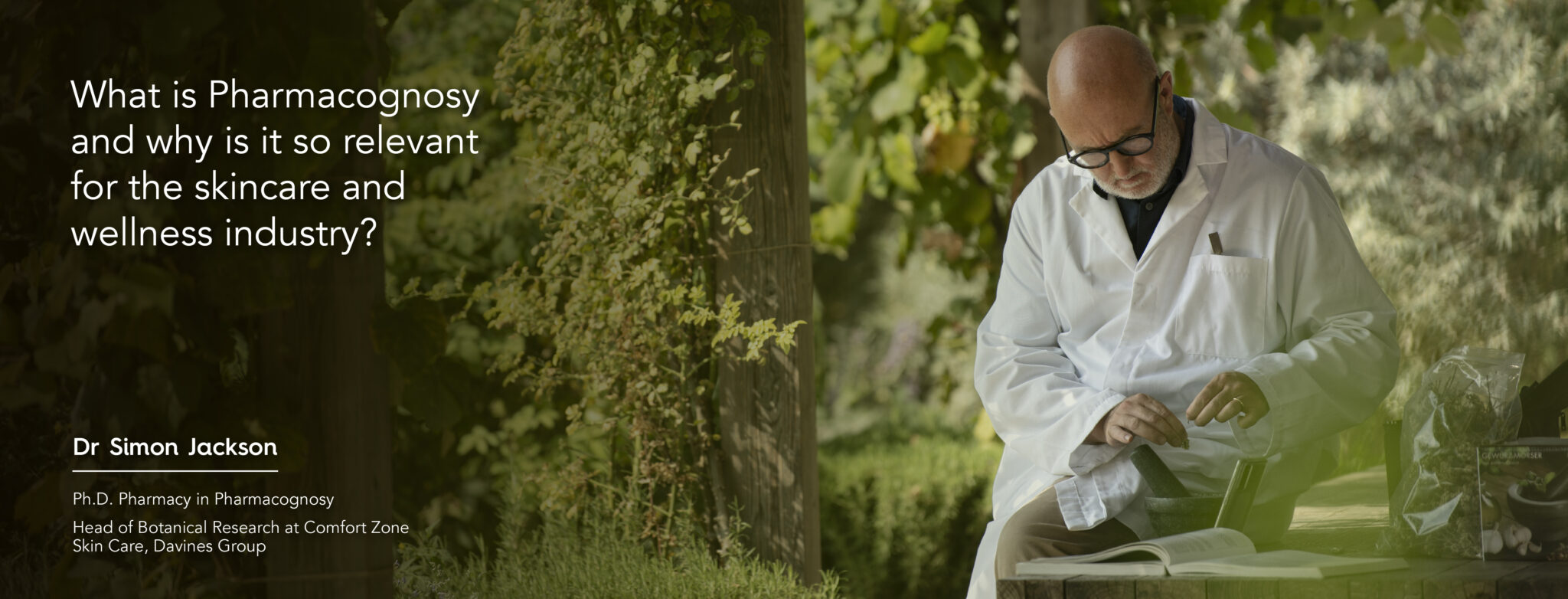Meet Dr. Simon Jackson, Ph.D. Pharmacy in Pharmacognosy and Head of Botanical Research at Comfort Zone Skin Care from the Davines Group who has dedicated his career to the study of plants and natural products and worked on the creation of some of the brand’s best sellers, such as Sublime Skin and Hydramemory. Dr. Jackson has worked closely with Comfort Zone in their European Regenerative Organic Center (EROC) to select and cultivate plants for study. He has worked even more closely with the formulators for the customization of the product lines and future innovations with bioactives and phytochemicals of particular interest: innovations guided by botanical science.
 Dr. Simon Jackson
Dr. Simon Jackson
Dr. Jackson shared with GOCO Hospitality his knowledge on “What is Pharmacognosy and why is it so relevant for the skincare and wellness industry?” by presenting the following findings.
- Around the world, medicines that come from living things are still a big deal for treating and preventing all sorts of illnesses. Now, pharmacognosy, as we like to call it, is the science of studying drugs and medicines that come from nature, like plants and other living things. It’s been a core part of pharmacy education for nearly two centuries.
- The term pharmacognosy was used for the first time by the Austrian physician Schmidt in 1811. Originally – during the 19th century and the beginning of the 20th century – “pharmacognosy” was used to define the branch of medicine or commodity sciences (“Warenkunde” in German) which dealt with drugs in their crude, or unprepared, form. Crude drugs are the dried, unprepared material of plant, animal or mineral origin, used for medicine. The study of these materials under the name Pharmakognosie was first developed in German-speaking areas of Europe, while other language areas often used the older term materia medica taken from the works of Galen and Dioscorides. In German the term drogenkunde (“science of crude drugs”) is also used synonymously”.
 Image Credit: Davines Group
Image Credit: Davines Group
- But here’s the fun part: pharmacognosy has gone through some serious changes over the years. Back in the day, it was mostly about describing plants and fungi, like a fancy botanical field. But in the last 50 years or so it’s a more interdisciplinary subject, its got all sciencey and started focusing more on phytochemistry and biology.
- These days, pharmacognosy isn’t just about plants anymore. It’s all about digging into compounds from plants, animals, and even tiny microorganisms, whether they live on land or in the ocean. And it’s not just about medicine either – it’s also about natural therapies (phytotherapy – plant based therapy) and fancy-sounding nutraceuticals and cosmeceuticals.
- Why is this all super relevant today? Well, people are going wild for herbal remedies (they call ’em phytomedicines) in Europe, North America, and Australasia. Walk into a pharmacy nowadays, and you’ll notice they’ve got a whole section dedicated to herbs. It’s crazy to think that even just 20 years ago, that wasn’t a thing.
- Take the United States as an example – they’ve got a wide offer of botanical ‘dietary supplements’ on the market, especially after they passed the Dietary Supplement Health and Education Act of 1994. In fact, a big survey found that in 2007, about 20% of American adults were spending big bucks, $14.8 billion to be exact, on ‘nonvitamin, nonmineral natural products.’
- So, brace yourself – interest in pharmacognosy is only going up from here. As we figure out more about how these natural goodies work in our bodies, the whole world of phytomedicines, nutraceuticals, cosmeceuticals and natural drugs is going to get even more attention. Stay tuned
 Image Credit: Davines Group
Image Credit: Davines Group
References:
- Pharmacognosy: Fundamentals, Applications, and Strategies” by Dr. Satyajit Sarker and Dr. Lutfun Nahar – This comprehensive textbook provides an in-depth understanding of pharmacognosy and its applications.
- “Natural Products: A Laboratory Guide” by Dr. Raphael Ikan – This book is a practical guide for the isolation and identification of natural products, which is a crucial aspect of pharmacognosy research.
- “Medicinal Natural Products: A Biosynthetic Approach” by Dr. Paul M. Dewick – This book explores the biosynthesis of natural products and their relevance to drug discovery.
- “Medicinal Plants: Chemistry and Properties” by Dr. Y.P.S. Pangtey and Dr. M.M. Srivastava – This book covers the chemical constituents and properties of various medicinal plants.
- “Phytochemistry” – A scientific journal that publishes research articles on the chemistry of plant constituents and their pharmacological activities.
- “Journal of Natural Products” – A research journal that focuses on natural products from various sources, including plants, fungi, and marine organisms.
- “Phytochemical Analysis” – A scientific journal that publishes articles on the analytical techniques used in the study of plant constituents.
- “Journal of Ethnopharmacology” – This journal publishes research on the traditional uses of plants and their pharmacological properties.
- “Planta Medica” – A journal that covers research on medicinal plants, natural products, and phytochemistry.
- “Phytotherapy Research” – A journal that focuses on the evaluation of herbal medicines and natural products for their therapeutic potential.
Publications:
- J.Jackson (July 2012) Sausage tree (Kigelia pinnata): An Ethnobotanical and Scientific Review. Herbalgram – The Journal of the American Botanical Council Number 94 p48-p59
- J.Jackson, P.J.Houghton, S. Retsas, A. Photiou. (March 2000) In Vitro Cytotoxicity of Norviburtinal and Isopinnatal from Kigelia pinnata against Cancer cell lines. Planta Medica v66 (2000) p 758-761
- Jackson, S.J. Houghton P, J., Photiou, A., Retsas S (1996) The isolation of a novel antineoplastic compound from a bioassay guided fractionation of stem bark and fruit extracts of Kigelia pinnata (Bignoniaceae) Mar-Apr 96. British Journal of Cancer Vol 73 N0170 p68
- Jackson S J. Enlisting Tree Sausage in the War on Cancer, (August 1995) National Geographic Vol 188, No2.
- Jackson, S.J. Houghton, P.J., Photiou, A., Retsas, S. Effects of fruit extracts and naphthoquinone’s isolated from Kigelia pinnata on melanoma cell lines. Presentation at the 36th Ann Meeting of the BACR, 2-5th April 1995 Nottingham. British Journal of Cancer Vol. 71, Suppl 24, 62. Abstract P153.
- Retsas, S. Photiou, A., & Jackson, S.J. Pharmaceuticals from Plants. The Lancet, Vol.344, NO 8917. 23rd July 1994
- Houghton, P.J., Photiou, A., Uddin, S., Shah, P., Browning, M., S.J Jackson. & Retsas, S. Activity of extracts of Kigelia pinnata against melanoma and renal carcinoma cell lines (1994). Planta Medica. 60. pp430-433

